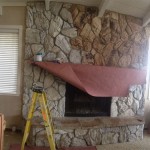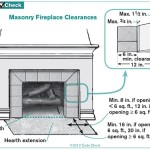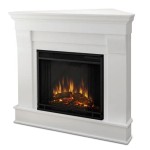How to Install a Mantel on a Stacked Stone Fireplace
Installing a mantel above a stacked stone fireplace can dramatically enhance the aesthetic appeal of a living space, providing a focal point and an opportunity for decorative display. However, the irregular surface of stacked stone presents unique challenges compared to installing a mantel on a traditional flat surface. The process requires careful planning, specialized tools, and a solid understanding of anchoring techniques to ensure the mantel is securely and safely mounted.
This article provides a comprehensive guide to installing a mantel on a stacked stone fireplace, covering essential considerations, necessary materials, step-by-step instructions, and safety precautions.
Key Considerations Before Installation
Before embarking on the installation process, several crucial factors must be taken into account. These considerations will influence the choice of materials, installation method, and overall safety of the project.
Mantel Weight and Dimensions: The weight and dimensions of the mantel are paramount. Stacked stone, while visually appealing, may not always provide a perfectly uniform and structurally sound substrate. A heavy mantel requires stronger anchoring methods than a lighter one. Measure the desired mantel width and depth, ensuring it complements the fireplace dimensions and surrounding room. Consider the projection (how far the mantel extends from the wall) and how it will impact traffic flow in the room.
Stone Type and Integrity: The type of stone used in the fireplace construction influences the installation process. Some stones are more porous than others, impacting the effectiveness of adhesives. Assess the integrity of the stone. Are any stones loose or cracked? Loose stones must be secured before proceeding to prevent the mantel from becoming unstable over time. Consider consulting a stonemason if you have concerns about the stone's structural integrity.
Fireplace Clearances and Building Codes: Fire safety is a critical concern. Local building codes specify minimum clearances between the fireplace opening and combustible materials, including the mantel. Consult local codes and the fireplace manufacturer's instructions to determine the required clearances. Failure to comply with these regulations could result in a fire hazard. Ensure the mantel is positioned at a safe distance above the firebox opening.
Desired Mantel Style and Mounting Method: Mantels come in various styles, from rustic wood beams to sleek modern designs. The chosen style will influence the mounting method. Options include floating mantels, which appear to be suspended from the wall, and traditional mantels supported by corbels or brackets. The mounting method should be compatible with the stacked stone surface and the mantel's weight.
Hidden Wiring and Utilities: Before drilling into the stone, carefully check for any hidden wiring, gas lines, or other utilities within the wall cavity. Using a stud finder with AC wire detection can help identify potential hazards. If uncertain, consult a qualified electrician or plumber.
Materials and Tools Required
Having the right tools and materials on hand will streamline the installation process and ensure a professional-looking result. The following is a comprehensive list of essential items:
Mantel: Choose a mantel made from a suitable material, such as wood, stone, or manufactured composite, considering its weight, style, and fire resistance.
Heavy-Duty Anchors: Select anchors specifically designed for use with stone or masonry. Options include sleeve anchors, wedge anchors, and chemical anchors (epoxy-based anchors). The choice depends on the mantel's weight and the stone's density. Consult a hardware specialist for recommendations.
Construction Adhesive: High-quality construction adhesive specifically designed for bonding stone or masonry will provide additional support and prevent movement of the mantel. Choose an adhesive that is compatible with the stone type and mantel material.
Shim Material: Wood or plastic shims are necessary to level the mantel and compensate for irregularities in the stacked stone surface. Choose shims of varying thicknesses to ensure a precise fit.
Drill with Masonry Bits: A hammer drill with a selection of appropriately sized masonry drill bits is essential for creating pilot holes for the anchors. Use high-quality carbide-tipped bits for optimal performance and longevity.
Level: A spirit level or laser level is crucial for ensuring the mantel is perfectly horizontal.
Stud Finder (with AC Wire Detection): A stud finder with AC wire detection helps locate studs and identify any hidden wiring or utilities within the wall.
Measuring Tape: Accurate measurements are critical for proper placement and alignment of the mantel.
Pencil: A pencil is needed for marking the desired mantel position and anchor locations.
Safety Glasses: Safety glasses protect the eyes from dust and debris during drilling and cutting.
Dust Mask: A dust mask prevents inhalation of stone dust and other airborne particles.
Caulk Gun: A caulk gun is used to apply construction adhesive and sealant.
Caulk or Sealant (optional): Paintable caulk or sealant can be used to fill gaps between the mantel and the stone, creating a seamless finish.
Wrench or Socket Set: A wrench or socket set is needed to tighten the anchors.
Hammer: A hammer may be needed to tap anchors into place.
Step-by-Step Installation Process
The following steps outline the process of installing a mantel on a stacked stone fireplace. Adhering to these instructions carefully will help ensure a safe and successful installation.
Preparation: Begin by thoroughly cleaning the stone surface where the mantel will be installed. Remove any dust, debris, or loose particles. Protect the surrounding area with drop cloths to prevent damage.
Marking the Mantel Position: Use a measuring tape and level to determine the desired mantel height and position. Mark the top edge of the mantel on the stone surface with a pencil. Ensure the mantel is level and centered above the fireplace opening, considering any required clearances.
Locating Anchor Points: Determine the appropriate anchor points based on the mantel's weight and dimensions. Ideally, anchor points should be spaced evenly along the mantel's length and positioned to coincide with solid stone, rather than grout lines. Mark the anchor locations on the stone surface, ensuring they align with the mantel's mounting hardware or support structure.
Drilling Pilot Holes: Using a hammer drill and the appropriate size masonry drill bit, carefully drill pilot holes at the marked anchor locations. Drill deep enough to accommodate the full length of the anchors. Use a slow, steady drilling speed to prevent cracking or chipping the stone. Avoid applying excessive pressure, allowing the drill bit to do the work. Regularly remove dust from the hole during drilling.
Installing Anchors: Insert the chosen anchors into the pilot holes. Follow the manufacturer's instructions for proper installation. Sleeve anchors and wedge anchors are typically inserted into the hole and then tightened to expand the anchor and secure it to the stone. Chemical anchors require injecting epoxy into the hole before inserting the anchor rod. Allow the epoxy to cure completely before proceeding.
Applying Construction Adhesive (Optional): Apply a generous bead of construction adhesive to the back of the mantel where it will contact the stone surface. This adhesive provides additional support and helps to prevent movement. Consider the type of stone, and the mantel material to ensure that you apply the correct adhesive.
Mounting the Mantel: Carefully position the mantel against the stone surface, aligning it with the marked position and anchor points. If using a floating mantel, slide it onto the anchor rods. If using a traditional mantel with corbels or brackets, attach them to the mantel first and then secure the entire assembly to the wall. Use shims as needed to level the mantel and compensate for any irregularities in the stone surface.
Securing the Mantel: Tighten the anchors using a wrench or socket set, ensuring they are securely fastened. Avoid overtightening, which could damage the stone or the anchors. Double-check the mantel's level and adjust the shims as needed.
Finishing Touches: Once the mantel is securely mounted, remove any excess construction adhesive. If desired, apply a bead of paintable caulk or sealant along the top and sides of the mantel to fill any gaps and create a seamless finish. Allow the caulk or sealant to dry completely before painting or decorating.
Safety Precautions
Safety should always be the top priority when undertaking any DIY project. The following safety precautions are essential when installing a mantel on a stacked stone fireplace:
Wear Safety Gear: Always wear safety glasses and a dust mask to protect your eyes and respiratory system from dust and debris.
Disconnect Power: Before drilling into the wall, disconnect power to any electrical circuits in the vicinity to prevent electric shock.
Use Proper Tools: Use the correct tools for the job and ensure they are in good working order. Use sharp drill bits to avoid applying excessive pressure, which could damage the stone.
Follow Manufacturer's Instructions: Carefully follow the manufacturer's instructions for all materials and tools, including anchors, adhesives, and sealants.
Avoid Overloading: Do not overload the mantel with excessive weight. Consider the mantel's weight capacity and the strength of the anchors.
Inspect Regularly: Periodically inspect the mantel and anchors to ensure they remain secure. If any problems are detected, take corrective action immediately.
Consult a Professional: If you are unsure about any aspect of the installation process, consult a qualified contractor or stonemason.

Fireplace Mantel Installation Before And After

How To Build And Hang A Mantel On Stone Fireplace Shanty 2 Chic

How To Build And Hang A Mantel On Stone Fireplace Shanty 2 Chic

Eldorado Stone Fireplace Installation With Mantel Time Lapse Installing Veneer

Installing A Heavy Wood Mantel 2024 Beginners Guide

How To Build And Hang A Mantel On Stone Fireplace Shanty 2 Chic

Guide Mantel Installation On A Stone Fireplace

Diy Fireplace Mantel

Fireplace Mantel Installation Casa Di Sassi

Install Fireplace Mantel Bracket Step By Guide








